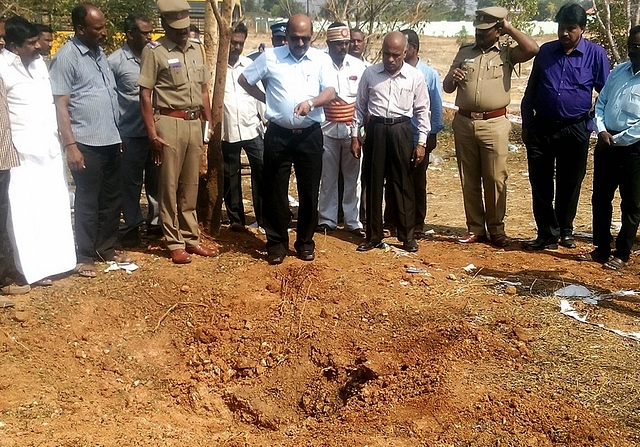
We May Have a New Enemy From Space: Janus-Faced Meteorites
However unrealistic, when it comes to the security of the nation and the world we should be prepared even for doomsday.
Meteorites can fall anytime, anywhere, sometimes stealthily and lethally. The government of India apparently does not recognise this canon. For some time now, I have been advocating the need for our India to possess planetary defence paraphernalia. The advocacy remains justified after the unfortunate and tragic turnaround of events, on 7 February, leading to a death, injuries and infrastructural damage in Vellore (Tamil Nadu, India), all due to meteorite impact.
Since we do not study disaster scenarios profusely, we often remain extremely unprepared for the worst. The small centimetre-scale 2016 Vellore meteorite, which proved fatal, is a reminder to our glaring unpreparedness in countering the impact of the more destructive metre-scale meteorites and extinction-level kilometre-scale asteroids or comets. Not to forget the fact that the Vellore meteorite fell on a day, 850 km away from Vishakhapatnam, where the Indian Navy was hosting the 2016 International Fleet Review.
What was the trajectory of this meteorite? Did it leave any trail in the atmosphere? Did it explode in the atmosphere? If yes, at what altitude did it explode? What parent object did it belong to? Were the ground-based radars able to identify the meteorite before its fall? Did it fell intact at one location or was it strewn at multiple locations? These are some of the many questions that are baffling the Indian scientific and defence communes.
The 2016 Vellore meteorite would probably go in history books as one that killed a person in India. Like I mentioned in my previous piece, meteorites have not been hitting the Indian subcontinent recently, they have been falling since eons. It was only last year that a meteorite fell in the populated district of Ernakulum in Kerala. Despite the 15-odd falls ‘recorded’ (some could have gone unrecorded) in the past 15 years in India, successive governments and their agencies have remain unalarmed about mitigating meteorite threats.
Disaster Management (DM) has been the forte of the National Disaster Management Authority (NDMA), the Department of Space (DOS), the Ministry of Home Affairs (MHA) and India’s defence forces. The formidable DM proficiencies of these agencies were witnessed during the 2013 Uttarakhand Floods, the 2013 Cyclone Phailin, the 2014 Cyclone Hudhud, and the 2015 Gujarat and South Indian floods to name a few. Yet our DM capacities have been limited only to certain natural disasters – earthquakes, tsunamis, cyclones, heat waves, landslides and floods.
The government of India has been preparing and relaying a first-hand DM protocol for intra-agency trip-wire only after a disaster has occurred. This has been our singular drawback. For instance, it was only after the 2004 Indian Ocean tsunami that the Ministry of Earth Sciences established a National Tsunami Early Warning System and which further led to the inclusion of tsunami-disasters in the NDMA’s above-mentioned list of mitigation capacities.
Likewise, it was only after the 2005 Mumbai floods that the government of India and NDMA prepared a definite DM protocol for urban flooding. The government of India should not therefore restrict NDMA to its response-based portfolio, which it is realising adeptly, but also equip it for a pre-emptive portfolio of disaster scenario planning. NDMA should grasp that only by working on scenarios, both realistic and unrealistic, it would be able to establish forecasting and mitigating capacities well in advance of any unusual disaster.
Now what should be done hereafter for meteorite disasters? First, the Narendra Modi-led NDA government should table a bill in the parliament. This bill and its resulting act would mandate current and future governments and its agencies to survey, identify, catalogue and distinguish Potentially Hazardous Objects – asteroids and comets – and alleviate threats emanating from them.
The ISRO should be given the task of establishing a high-resolution multi-spectrum ground- and space-based reconnaissance network that would track PHOs as small as one metre. ISRO should also be directed to carry out space missions to asteroids and comets, for their characterisation, and with an aim to deflect any object potentially hazardous to Earth.
The DRDO and MoD should be tasked to develop kinetic kill and deflection vehicles that could neutralise a PHO outside the atmosphere and without generating chunk debris. Such kill vehicles should be easy to integrate on conventional and operational air-defence platforms as well as on ISRO’s Polar Satellite Launch Vehicle.
The NDMA and its parent MHA should develop a DM protocol for meteorite strikes, which at present it does not possess at all. Meteorites are Janus-faced. They are known in the scientific community for bringing prebiotic molecules to early Earth that could have led to origin of life – a constructive act – and they are also known for extinction of dinosaurs – a destructive act.
Our preparedness would only help us avoid encountering the destructive avatar of meteorites. Even if the probability of an extinction-level kilometre-scale asteroid or comet falling on Earth is once in several million years, we should not be complacent.
The striking of a much smaller metre-scale meteorite on the surface would unleash explosive energies a thousand times stronger than the Nagasaki and Hiroshima bombs and could lead to several thousand casualties. Such a strike would lead to grave environmental impact, causing global upheaval. However unrealistic, when it comes to the security of the nation and the world we should be prepared even for doomsday.